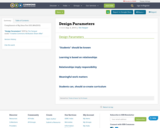
Compliments of Big Ideas Fest 2013 (#bif2013)

Compliments of Big Ideas Fest 2013 (#bif2013)
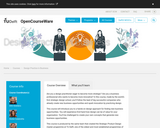
Are you a design practitioner eager to become more strategic? Are you a business professional who wants to become more innovative? In this course, made by the world’s first strategic design school, you’ll follow the lead of big successful companies who already create new business opportunities and spark innovation by practicing design.
This course will introduce you to a hands-on design approach for finding new business opportunities. You will experience first-hand how design can be of value for your organisation. You’ll be challenged to create your own concepts that generate new business opportunities.
This course is produced by the same team that created the Strategic Product Design master programme at TU Delft, one of the oldest and most established programmes of strategic design in the world. Moreover, industry experts will help bridging design practice and business theory in a way that is unique in the present educational landscape.
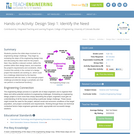
Students practice the initial steps involved in an engineering design challenge. They begin by reviewing the steps of the engineering design loop and discussing the client need for the project. Next, they identify a relevant context, define the problem within their design teams, and examine the project's requirements and constraints. (Note: Conduct this activity in the context of a design project that students are working on, which could be a challenge determined by the teacher, brainstormed with the class, or the example project challenge provided [to design a prosthetic arm that can perform a mechanical function].)
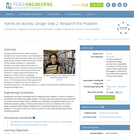
Through Internet research, patent research, standards and codes research, user interviews (if possible) and other techniques (idea web, reverse engineering), students further develop the context for their design challenge. In subsequent activities, the design teams use this body of knowledge about the problem to generate product design ideas. (Note: Conduct this activity in the context of a design project that students are working on, which could be a challenge determined by the teacher, brainstormed with the class, or the example project challenge provided [to design a prosthetic arm that can perform a mechanical function]. This activity is Step 2 in a series of six that guide students through the engineering design loop.)
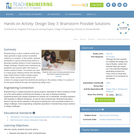
Brainstorming is a team creativity activity that helps generate a large number of potential solutions to a problem. In this activity, students participate in a group brainstorming activity to generate possible solutions to their engineering design challenge. Students learn brainstorming guidelines and practice within their teams to create a poster of ideas. The posters are used in a large group critiquing activity that ultimately helps student teams create a design project outline. (Note: Conduct this activity in the context of a design project that students are working on; this activity is Step 3 in a series of six that guide students through the engineering design loop.)
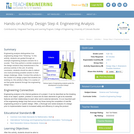
Engineering analysis distinguishes true engineering design from "tinkering." In this activity, students are guided through an example engineering analysis scenario for a scooter. Then they perform a similar analysis on the design solutions they brainstormed in the previous activity in this unit. At activity conclusion, students should be able to defend one most-promising possible solution to their design challenge. (Note: Conduct this activity in the context of a design project that students are working on; this activity is Step 4 in a series of six that guide students through the engineering design loop.)
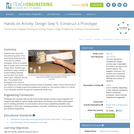
Students learn about the manufacturing phase of the engineering design process. They start by building prototypes, which is a special type of model used to test new design ideas. Students gain experience using a variety of simple building materials, such as foam core board, balsa wood, cardstock and hot glue. They present their prototypes to the class for user testing and create prototype iterations based on feedback. (Note: Conduct this activity in the context of a design project that students are working on; this activity is Step 5 in a series of six that guide students through the engineering design loop.)

As students learn more about the manufacturing process, they use the final prototypes created in the previous activity to evaluate, design and manufacture final products. Teams work with more advanced materials and tools, such as plywood, Plexiglas, metals, epoxies, welding materials and machining tools. (Note: Conduct this activity in the context of a design project that students are working on; this activity is Step 6 in a series of six that guide students through the engineering design loop.)
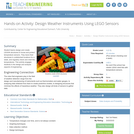
Student teams design and create LEGO® structures to house and protect temperature sensors. They leave their structures in undisturbed locations for a week, and regularly check and chart the temperatures. This activity engages students in the design and analysis aspects of engineering.
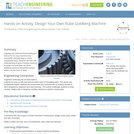
Engineer and cartoonist Rube Goldberg is famous for his crazy machines that accomplish everyday tasks in overly complicated ways. Students use their new understanding of types of simple machines to design and build their own Rube Goldberg machines that perform simple tasks in no less than 10 steps.
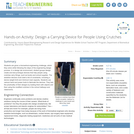
Students are given a biomedical engineering challenge, which they solve while following the steps of the engineering design process. In a design lab environment, student groups design, create and test prototype devices that help people using crutches carry things, such as books and school supplies. The assistive devices must meet a list of constraints, including a device weight limit and minimum load capacity. Students use various hand and power tools to fabricate the devices. They test the practicality of their designs by loading them with objects and then using the modified crutches in the school hallways and classrooms.

In this interactive lesson plan, students collaborate to design a Mars base, applying concepts in engineering, architecture, and sustainability. Working in teams, they creatively solve challenges related to life support, resource management, and adapting to Martian conditions. Students draw out detailed floor plans for their innovative designs, showcasing their understanding of STEM principles and presenting their vision for a functional Martian habitat.
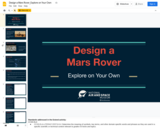
In this Explore on Your Own activity, students will design a rover to explore the surface of Mars and determine if there are any signs of past life.
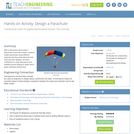
After a discussion about what a parachute is and how it works, students create parachutes using different materials that they think will work best. They test their designs, and then contribute to a class discussion (and possible journal writing) to report which paper materials worked best.
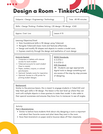
Students are tasked with designing a room of their choice in TinkerCAD. After learning the basic tools and navigation from modeling objects, they can begin to model collections of objects enabling them to visualize and personalize their dream spaces. Experimenting with layout, furniture, and décor helps develop their spatial awareness and design skills. The lesson concludes with an (optional) presentation, where participants present their room designs and reflect on their creative decisions and practical layouts.
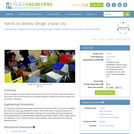
Students design and build a model city powered by the sun! They learn about the benefits of solar power, and how architectural and building engineers integrate photovoltaic panels into the design of buildings.
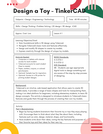
In this TinkerCAD lesson, students design their favorite toy using 3D modeling software. They learn basic TinkerCAD tools and techniques to create and customize their toy designs. Throughout the lesson, students apply principles of geometry and spatial reasoning while fostering creativity and problem-solving skills. The session concludes with students presenting their designs and discussing the features and functionality of their creations.
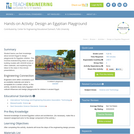
Student teams use their knowledge about ancient Egypt to design playgrounds for Egyptian children. This involves brainstorming ideas on paper, building models with LEGO® bricks or other materials, and explaining their ideas to the class in five-minute presentations.

In this two-part activity, students design and build Rube Goldberg machines. This open-ended challenge employs the engineering design process and may have a pre-determined purpose, such as rolling a marble into a cup from a distance, or let students decide the purposes.
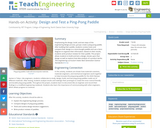
Emphasizing the design, build, and test steps of the engineering design process, groups create a ping-pong paddle. After building their paddle, students conduct tests and compare their design to a store-bought paddle and use a Venn diagram to organize their information. Based on their results, students write product reviews for their paddle. This project allows students to build and test a design, iterate upon that design as well as explore how data analysis of a product works.